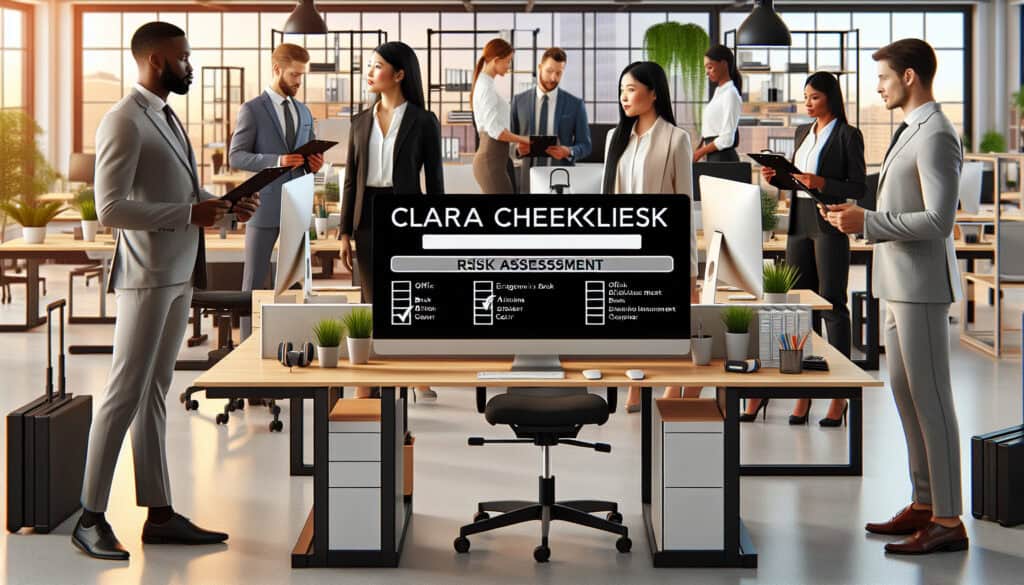أداة قائمة على قائمة مرجعية مصممة لإجراء تقييم أولي سريع لـ مريح المخاطر في مكان العمل.
- المنهجيات: لين سيجما, تصنيع
CLaRA (القائمة المرجعية لتقييم المخاطر)

CLaRA (القائمة المرجعية لتقييم المخاطر)
- التحسين المستمر, بيئة العمل, العوامل البشرية, هندسة العوامل البشرية (HFE), تحسين العمليات, إدارة الجودة, تحليل المخاطر, إدارة المخاطر, أمان
الهدف:
كيفية استخدامه:
- يوفر نظام CLaRA مجموعة منظمة من الأسئلة لتوجيه المراقب من خلال فحص أولي للمخاطر البدنية والوضعية والبيئية المرتبطة بالمهمة، مما يساعد على تحديد أولويات الوظائف التي تحتاج إلى تقييم أكثر تفصيلاً.
الايجابيات
- بسيطة وسريعة الاستخدام، وتتطلب الحد الأدنى من الخبرة في مجال بيئة العمل للفحص الأولي، وتساعد على تحديد مجموعة واسعة من المخاطر وترتيب أولوياتها بشكل منهجي.
سلبيات
- تعمل كأداة فرز وليس تحليلًا تفصيليًا؛ قد تغيب عنها عوامل الخطر المعقدة أو الدقيقة؛ يمكن أن تكون تصنيفات المخاطر غير موضوعية.
الفئات:
- بيئة العمل, الموارد البشرية, إدارة المخاطر
الأفضل لـ
- إجراء فحص أولي سريع وبسيط للمخاطر المريحة في مكان العمل لتحديد أولويات العمل الإضافي.
تُستخدم منهجية CLaRA كأداة عملية قابلة للتطبيق على نطاق واسع في مختلف الصناعات التي تكون فيها بيئة العمل البيئية والبدنية ذات صلة، مثل التصنيع والرعاية الصحية والخدمات اللوجستية. يمكن استخدام هذه المنهجية في المراحل المبكرة من المشروع، لا سيما أثناء التقييمات الأولية لمخاطر مهام العمل لتحديد المخاطر المحتملة وأوجه القصور المريحة التي قد تؤدي إلى إصابات في مكان العمل أو انخفاض الإنتاجية. من خلال إشراك أعضاء الفريق من مختلف الأقسام، مثل مسؤولي السلامة والمهندسين والمتخصصين في مجال السلامة والمريحة، يمكن للمؤسسات ضمان إجراء تقييم شامل، مما يسهل اتباع نهج تعاوني لحل المشاكل. في البيئات التي تكون فيها النماذج الأولية السريعة وعمليات التصميم التكرارية شائعة، يوفر نظام CLaRA وسيلة فعالة لتحديد أولويات المهام وتخصيص الموارد بفعالية، حيث يتيح للفرق تحديد الوظائف التي تتطلب مزيدًا من الاستكشاف بسرعة قبل التدخلات الهندسية المكثفة. يلقى تنسيق قائمة المراجعة المنظمة هذا صدى جيدًا لدى مختلف أصحاب المصلحة، مما يسمح بالمشاركة دون الحاجة إلى معرفة متقدمة ببيئة العمل، مما يجعلها في متناول جمهور أوسع داخل المؤسسة. كما يمكن أن يؤدي تحديد أولويات المخاطر المستمدة من تقييمات CLaRA إلى تطوير برامج تدريبية تهدف إلى تحسين وعي العمال والحد من المخاطر المحتملة في الممارسات اليومية، مما يساهم بشكل أكبر في توفير بيئة عمل أكثر أمانًا. وتماشيًا مع ممارسات التحسين المستمر، يمكن للشركات تنفيذ تقييمات CLaRA بشكل روتيني كجزء من عمليات تدقيق الصحة والسلامة أو مراجعات الأداء لضمان تكيف معايير الهندسة البشرية مع متطلبات العمل والتقنيات المتطورة.
الخطوات الرئيسية لهذه المنهجية
- تحديد المهمة المراد تقييمها وفهم السياق الذي يتم فيه تنفيذها.
- تحليل المتطلبات البدنية للمهمة، بما في ذلك الحركات المتكررة والتعامل مع الأشياء.
- تقييم مخاطر الوضعية، مثل الأوضاع المحرجة التي قد تؤدي إلى عدم الراحة أو الإصابة.
- افحص الظروف البيئية التي يمكن أن تسهم في حدوث المخاطر، بما في ذلك الإضاءة وتخطيط مساحة العمل.
- تحديد أولويات المخاطر بناءً على درجة خطورتها واحتمالية حدوثها لتحديد المخاطر التي تتطلب المزيد من التقييم.
نصائح للمحترفين
- قم بإشراك أعضاء الفريق في عملية التقييم لاكتساب رؤى متنوعة وتحديد المخاطر التي تم التغاضي عنها.
- قم بتحديث قائمة مراجعة CLaRA بانتظام مع النتائج المريحة الجديدة أو التغييرات التنظيمية للحفاظ على ملاءمتها.
- دمج نتائج تقرير تقييم المخاطر المحلية مع البيانات الكمية المستقاة من تقارير الإصابات لوضع استراتيجية أكثر قوة لتحديد أولويات المخاطر.
لقراءة عدة منهجيات ومقارنتها, نوصي باستخدام
> مستودع المنهجيات الشامل <
مع أكثر من 400 منهجية أخرى.
نرحب بتعليقاتكم على هذه المنهجية أو المعلومات الإضافية على قسم التعليقات أدناه ↓، وكذلك أي أفكار أو روابط متعلقة بالهندسة.
السياق التاريخي
1986
(إذا كان التاريخ غير معروف أو غير ذي صلة، على سبيل المثال "ميكانيكا الموائع"، يتم تقديم تقدير تقريبي لظهوره الملحوظ)

منشورات ذات صلة
حاسبة METS إلى السعرات الحرارية
التحليل التلوي
تخطيط الرسائل
مخططات النموذج الذهني
الحد الأقصى لقوى الدفع والسحب المقبولة
تخطيط الاحتياجات المادية (MRP)